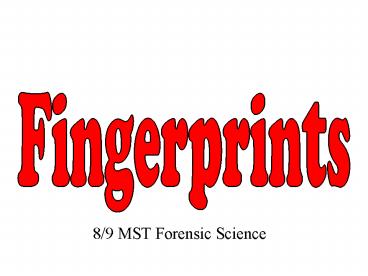8/9 MST Forensic Science - PowerPoint PPT Presentation
1 / 11
Title:
8/9 MST Forensic Science
Description:
8/9 MST Forensic Science Fingerprint Principles According to criminal investigators, fingerprints follow 3 fundamental principles: A fingerprint is an individual ... – PowerPoint PPT presentation
Number of Views:211
Avg rating:3.0/5.0
Title: 8/9 MST Forensic Science
1
Fingerprints
- 8/9 MST Forensic Science
2
Fingerprint Principles
- According to criminal investigators, fingerprints
follow 3 fundamental principles - A fingerprint is an individual characteristic no
two people have been found with the exact same
fingerprint pattern. - A fingerprint pattern will remain unchanged for
the life of an individual however, the print
itself may change due to permanent scars and skin
diseases. - Fingerprints have general characteristic ridge
patterns that allow them to be systematically
identified.
3
Fingerprint Classes
- There are 3 specific classes for all fingerprints
based - upon their visual pattern arches, loops, and
whorls. - Each group is divided into smaller groups
as seen in the lists below.
4
Interesting Info
Fingerprint Factoid 60 of people have loops,
35 have whorls, and 5 have arches
- Did you know?
- Dactyloscopy is the study of fingerprint
identification. Police investigators are experts
in collecting dactylograms, otherwise known as
fingerprints.
5
Arches
Arches are the simplest type of fingerprints that
are formed by ridges that enter on one side of
the print and exit on the other. No deltas are
present.
6
Loops
Loops must have one delta and one or more ridges
that enter and leave on the same side. These
patterns are named for their positions related to
the radius and ulna bones.
NOTE On the left hand, a loop that opens to the
left would be an ulnar loop, while one that opens
to the right would be a radial loop.
7
Whorls
Whorls have at least one ridge that makes (or
tends to make) a complete circuit. They also
have at least two deltas. If a print has more
than two deltas, it is most likely an accidental.
Central Pocket Whorl
Plain Whorl
Draw a line between the two deltas in the plain
and central pocket whorls. If some of the curved
ridges touch the line, it is a plain whorl. If
none of the center core touches the line, it is a
central pocket whorl.
8
Whorls Part 2
9
Identify each fingerprint pattern.
?
A
B
Right Hand
Left Hand
C
E
Right Hand
D
Left Hand
Right Hand
10
Avoid Partial Prints
GOOD PRINTGet as much of the top part of your
finger as possible!
11
Directions
1st Roll the pad portion of your thumb over
the ink pad from the left side of your thumb to
the right. You do not have to push down really
hard!
2nd Roll the pad portion of your thumb from
the left side of your thumb to the right in the
correct box on your paper to make a thumbprint.
3rd Continue this process to make a fingerprint
of all ten fingers on the My Prints worksheet.
4th Use your notes and a magnifying lens to help
you figure out what type of pattern is found in
each of your fingerprints. Label each one with
the patterns name.































